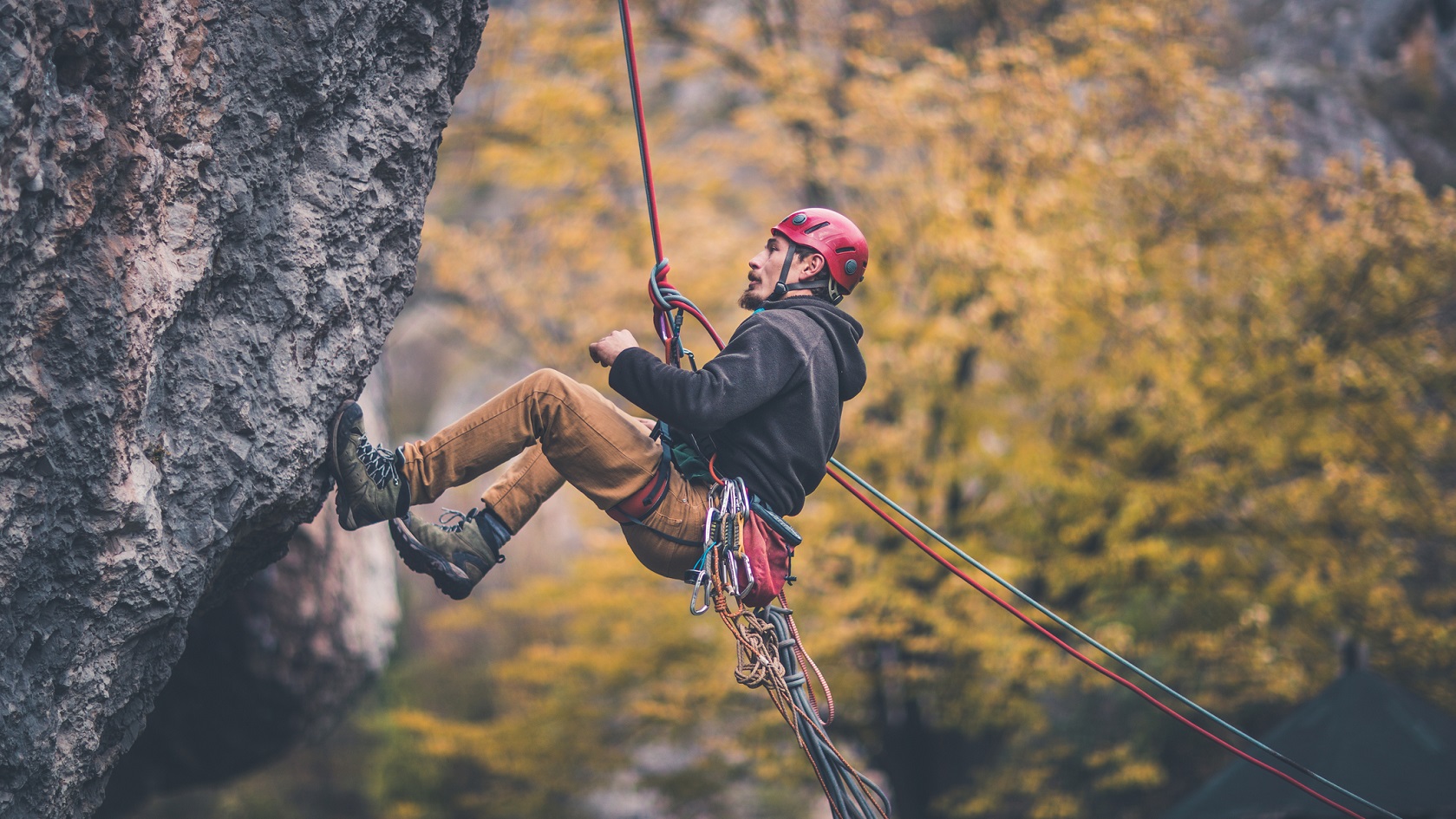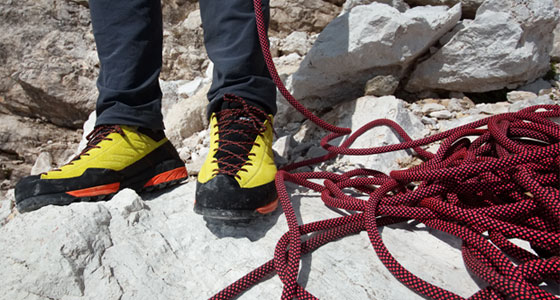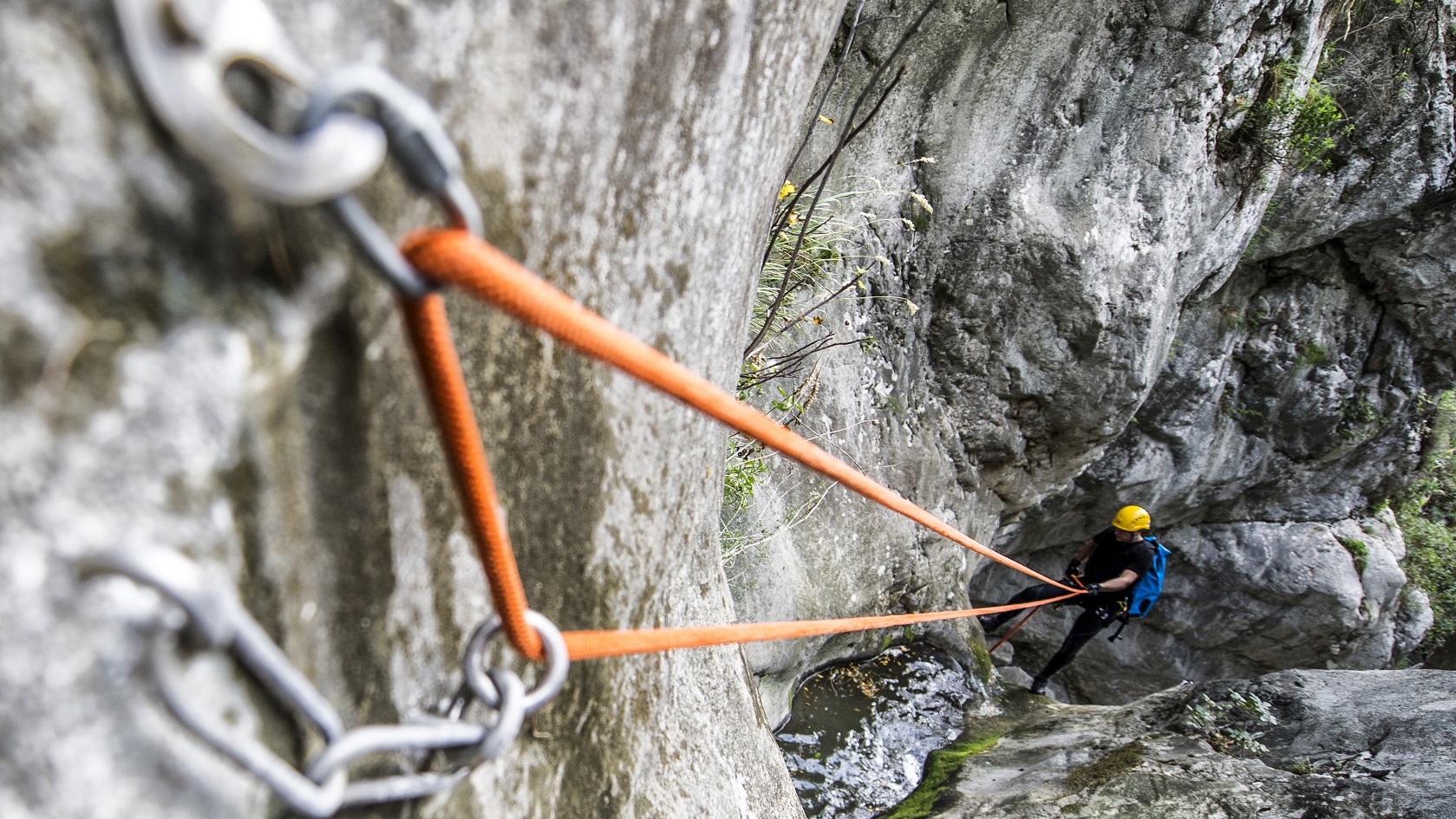Which Climbing Rope is Right for You?

Climbing Ropes Buying Guide
Half way up a cliff face, with burning forearms, shaky legs and your last piece of protection a little too far away; not the time to start thinking about the quality of your climbing rope. Or is it?
Modern construction techniques, rigorous testing and stringent safety guidelines mean that the humble rope has never been so strong, light and durable. But with such a wide array of options, how do you know which is the right one for you?
If you’re thinking about buying a new rope then we have put together this easy to understand climbing rope buying guide to help you make the best, and the safest decision for yourself.
Important Safety Information
Generally speaking, there are two main types of rope available, ‘static’ and ‘dynamic’.
All ropes that are safe to use for climbing are referred to as dynamic. This means that they stretch under a weighted load.
Dynamic Ropes
Dynamic climbing ropes are essential safety equipment for many climbing disciplines, especially where falls are likely or protection placements are less secure. Their unique ability to stretch under load distinguishes them from static ropes, making them the preferred choice for most lead climbing scenarios.
Energy Absorption During Falls
Dynamic ropes are designed to stretch significantly when loaded, such as during a fall.
This stretch absorbs a large portion of the fall’s energy, reducing the impact force transmitted to both the climber and the protection system.
Protection Placement Security
By absorbing energy, dynamic ropes help prevent the top piece of protection from being ripped out during a fall.
The reduced shock load also minimises the risk of a “zipper effect,” where multiple pieces of protection could be sequentially pulled out, especially in traditional (trad) climbing.
Climber Safety and Comfort
The rope’s elasticity makes falls less jarring on the climber’s body.
This reduces the risk of injuries such as whiplash, bruising, or internal strain, making dynamic ropes much kinder on the body compared to static ropes.
- Trad climbing often relies on removable protection (nuts, cams, etc.) that may not withstand high shock loads.
- The ability of a dynamic rope to dissipate energy is crucial for maintaining the integrity of these placements and ensuring climber safety.
Other Considerations
- Versatility: Dynamic ropes are also used in sport climbing, alpine climbing, and mountaineering, wherever falls are possible.
- Types: They come in various diameters and lengths, tailored for single, half, or twin rope systems, allowing climbers to choose the best option for their discipline and terrain.
Static Ropes
Static ropes are a specialised type of rope used in climbing and other vertical activities. Unlike dynamic ropes, static ropes are designed not to stretch under load. This lack of elasticity makes them unsuitable-and even dangerous-for most types of climbing where falls are possible.
- No Stretch = High Impact Force
- Static ropes do not absorb energy during a fall.
- If used for lead climbing, seconding, or top roping, the lack of stretch would result in a dangerously high shock load on both the climber and the anchor system.
- This can lead to severe injury, equipment failure, or anchor points being ripped out.
Static ropes are invaluable for tasks where stretch is undesirable and precise, controlled movement is required. These include:
- Hauling Gear
- Ideal for pulling heavy loads (haul bags, equipment) up a wall or route.
- Jumaring (Ascending)
- Used with ascenders to climb up a fixed rope efficiently and safely.
- Abseiling (Rappelling)
- Provides a stable, predictable descent without bouncing or stretching.
- Caving
- Perfect for vertical cave systems, where controlled movement is more important than fall protection.
When to Use Static Ropes
- Only use static ropes when:
- There is no risk of a fall that needs to be absorbed by the rope.
- The primary need is for stability, control, and minimal rope movement.
Summary
| Activity | Rope Type | Reason |
|---|---|---|
| Lead Climbing | Dynamic | Absorbs fall energy |
| Seconding/Top Roping | Dynamic | Reduces shock load in falls |
| Hauling Gear | Static | No stretch, efficient hauling |
| Jumaring/Ascending | Static | Stable, easy to climb |
| Abseiling/Rappelling | Static | Smooth, controlled descent |
| Caving | Static | Precise movement, no bounce |
Important Safety Information
Single Ropes
Single ropes are the most common and adaptable type of climbing rope. Their primary advantage is versatility-they can be used for a wide range of climbing activities, from indoor gym sessions and outdoor sport routes to big multi-pitch climbs, mountaineering, and even ice climbing. This makes them a go-to choice for both beginners and experienced climbers.
Key Uses for Single Ropes
- Indoor climbing gyms
- Outdoor sport climbing
- Multi-pitch trad routes
- Mountaineering
- Ice climbing
Choosing the Right Single Rope
When selecting a single rope, several important factors should be considered to match your climbing style and environment.
Diameter
Thicker ropes (around 10mm):
More durable and resistant to abrasion.
Easier to handle, especially for beginners.
Ideal for frequent indoor use or top roping.
Thinner ropes (as low as 8.9mm):
Lighter and more flexible.
Better for long outdoor routes, multi-pitch climbs, or when weight savings are important.
Less durable and may wear out faster with heavy use.
Length
Shorter ropes (30m):
Perfect for indoor climbing where routes are shorter.
Easier to manage in crowded gyms.
Longer ropes (50–60m):
Essential for outdoor climbing, allowing access to longer pitches and safer abseils.
Provide greater freedom and flexibility on varied terrain.
Special Treatments
- Water-resistant coatings:
- Important for mountaineering, ice climbing, or any environment where the rope might get wet.
- Helps prevent the rope from absorbing water, which can add weight and reduce performance.
Summary
| Climbing Activity | Recommended Length | Recommended Diameter | Special Features |
|---|---|---|---|
| Indoor Gym | 30m | 10mm | None needed |
| Outdoor Sport | 50-60m | 9.5-10mm | Optional dry treatment |
| Multi-Pitch/Alpine | 60m | 8.9-9.5mm | Dry-treated recommended |
| Ice Climbing | 60m | 8.9-9.5mm | Dry-treated essential |
Balancing Weight and Durability
As rope length increases, weight becomes a more significant factor. Opting for a thinner rope reduces weight and increases dexterity, making it easier to handle on long or technical climbs. However, thinner ropes are generally less robust and may not last as long under heavy use. Always consider your primary climbing environment and how much durability you need.
Single ropes offer unmatched versatility, but choosing the right diameter, length, and treatments will ensure you get the best performance and safety for your climbing adventures.
Half Ropes
Half ropes (also called double ropes) are a specialised system designed for long, wandering trad routes and multi-pitch climbs. By using two thinner ropes in tandem, climbers gain critical advantages in safety, rope management, and versatility.
Key Features of Half Ropes
- Diameter: Typically 8–9mm, thinner than single ropes (9–10mm) for reduced weight.
- Usage: Always used in pairs, with each rope clipped to separate protection points.
- Colours: Two distinctly different colours (e.g., blue and orange) to avoid confusion while clipping or belaying.
Why Use Half Ropes?
1. Reduced Rope Drag
- Parallel Clipping: Each rope follows a straighter path on either side of the climber, avoiding zigzagging and friction.
- Wandering Routes: Ideal for trad climbs with zigzagging protection (e.g., cracks, traverses).
- Gear Stability: Prevents protection from being pulled sideways, which can dislodge placements.
2. Safety Advantages
- Redundancy: If one rope is cut by sharp rock or ice, the second remains intact.
- Lower Impact Force: Thinner ropes stretch more, reducing force on marginal gear (e.g., ice screws, small cams).
- Abseiling: Tie both ropes together for full-length rappels (e.g., 60m + 60m = 120m descent).
3. Trad Climbing Efficiency
- Alternate Clipping: Clip the left rope to left-side gear and the right rope to right-side gear.
- Belayer Control: Belayers manage two ropes independently to minimise tangles.
How to Use Half Ropes
- Clipping Technique: Alternate ropes at each piece to maintain equal tension and reduce drag.
- Belaying: Use a twin-rope belay device to handle both ropes smoothly.
- Abseiling: Join ropes with a double fisherman’s knot for full-length descents.
Half vs Single Ropes
| Factor | Half Ropes | Single Ropes |
|---|---|---|
| Rope Drag | Minimal on wandering routes | High on zigzagging paths |
| Weight | Lighter per rope (but two required) | Heavier, bulkier |
| Safety | Redundant if one rope fails | Single point of failure |
| Use Case | Trad, alpine, ice | Sport, gym, straightforward routes |
Best Practices
- Colour Differentiation: Choose ropes with high-contrast colours (e.g., neon yellow + black) for easy identification.
- Skill Level: Requires practice to master clipping and belaying techniques.
- Durability: Thinner ropes wear faster-inspect regularly for sheath damage.
Half ropes are indispensable for adventurous trad climbers, offering unmatched flexibility on complex routes while enhancing safety through redundancy and reduced drag. For alpine objectives or ice-climbing scenarios where gear placements are marginal, they provide critical peace of mind.
Construction
Modern climbing ropes use kernmantle construction, combining a protective outer sheath (mantle) with a load-bearing core (kern). This design optimises strength, durability, and performance for both dynamic and static applications.
1. The Core (Kern)
The core provides 80-90% of the rope’s tensile strength and determines its elongation properties.
Materials: Nylon filaments spun into yarn, then twisted into plies and bundled.
Dynamic vs. Static:
Dynamic ropes: Core fibres are heavily twisted to act like springs, absorbing fall energy through controlled stretching (8–12% elongation under load).
Static ropes: Use straight or lightly twisted cores to minimise stretch (<5% elongation).
Twist Process:
Z-twist: Right-handed twist for stability.
S-twist: Left-handed twist to balance rope rotation during use.
2. The Sheath (Mantle)
The sheath protects the core from abrasion, UV damage, and environmental wear.
Materials: Nylon fibres braided tightly around the core.
Key Features:
Tight weave: Enhances durability (e.g., 32- to 48-carrier patterns).
Coatings: Water-repellent treatments applied post-braiding to resist moisture.
Bonded vs. Unbonded:
Bonded: Core and sheath adhere, preventing slippage and improving handling.
Unbonded: Traditional design, lighter but prone to sheath migration.
3. Manufacturing Process
Core Creation:
Filaments → Yarn → Twisted Plies → Bundled Core.
Dynamic cores receive multiple twists to boost elasticity.
Sheath Braiding:
Machines weave sheath yarns around the core using 2-over-2 braiding for abrasion resistance.
Finishing:
Heat treatment: Stabilises fibres and seals ends.
Testing: UIAA drop tests (5+ falls for single ropes) and impact force checks (<12 kN).
Choosing the right climbing rope is essential for safety, performance, and enjoyment on the rock or ice. Whether you opt for a versatile single rope, the specialised control of half ropes, or the durability of static ropes for specific tasks, understanding rope construction, diameter, length, and treatment will help you make an informed decision. Always consider your climbing style, environment, and priorities to select a rope that meets your needs and keeps you secure on every adventure.
Climbing Rope FAQs
Climbing ropes are divided into dynamic and static types. Dynamic ropes stretch to absorb falls and are used for lead, trad, and sport climbing. Static ropes stretch very little and are designed for hauling, abseiling, or rescue, but should never be used for lead or top-rope climbing.
Single ropes are used alone and suit most sport, trad, and gym climbing. Half ropes are used in pairs, clipped alternately for trad or alpine routes to reduce rope drag. Twin ropes are also used in pairs but always clipped together, ideal for alpine or ice climbing.
Thinner ropes (8.9–9.4mm) are lighter and best for long or multi-pitch climbs, but less durable and require skilled belaying. Medium diameters (9.5–9.9mm) balance durability and weight for all-around use. Thicker ropes (10mm+) are more durable and ideal for top-roping or frequent falls.
A 60m rope is standard for most outdoor climbing, but always check route length-your rope should be at least twice the length of the longest pitch. Some modern sport routes require a 70m rope. For indoor climbing, shorter ropes (30–40m) may suffice.
Dry-treated ropes have a water-repellent coating, making them more durable and less likely to absorb water. They are recommended for ice climbing, mountaineering, or wet environments. Non-dry ropes are fine for indoor or fair-weather outdoor climbing and are usually more affordable.
Replace your rope if you notice significant fraying, flat spots, core exposure, or after a severe fall. Frequent use, age, and exposure to chemicals or sunlight also degrade ropes-always follow manufacturer guidelines for lifespan and inspection.
Keep your rope clean by washing it with mild soap and water. Avoid stepping on it, store it in a cool, dry place away from direct sunlight and chemicals, and use a rope bag to prevent dirt and abrasion.
Related Articles

Let us know you agree to cookies
We use marketing, analytical and functional cookies as well as similar technologies to give you the best experience. Third parties, including social media platforms, often place tracking cookies on our site to show you personalised adverts outside of our website.
We store your cookie preferences for two years and you can edit your preferences via ‘manage cookies’ or through the cookie policy at the bottom of every page. For more information, please see our cookie policy.






